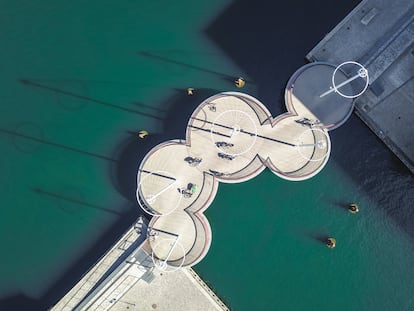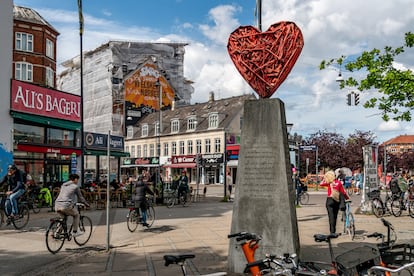Bridges and bike lanes: What to see in Copenhagen beyond cultural offerings
One of the great attractions of the Danish capital is its public transportation, which links its neighborhoods and makes life easier for residents and tourists alike via subways, buses, boats and bikes

If the Danish capital feels like a friendly and welcoming city, a city one can trust, it’s in part thanks to its understanding and promotion of urban mobility. Copenhagen’s dimensions favor the commute, but its topography does not. The city is flat, aquatic, and insular, its canals both large and small traversed by many bridges, each one with its own unique character and history. Some connect disparate corners of the metropolitan area, some decongest traffic, and some can even be raised to allow for the passage of boats.
Here too are bridges that one can only cross on foot or on bike, like the Cirkelbroen, which was designed by Studio Olafur Eliasson. It is located in Christianshavn, a neighborhood made up of a series of artificial islands. The bridge consists of five masts and five circular platforms of varying size, and serves as a nod to Denmark’s shipping history, its design simulating an old ship docked at the quay. To see the Cirkelbroen in its entirety, it’s best to board a craft operated by the company GoBoat — which offers the option to rent boats you can steer yourself — and pass underneath the bridge. The experience of viewing Copenhagen from the water, such an omnipresent element of the city, is highly recommended. Another bridge of note is Dronning Louises Bro, which was constructed in 1887, crosses a narrow lake and connects the city center with Nørrebro, a lively neighborhood that is also home to the Assistens cemetery, where Hans Christian Andersen, author of children’s stories like The Little Mermaid and The Emperor’s New Clothes, as well as the philosopher Søren Kierkegaard, are buried.

In Nørrebro, there are ample restaurants, bars and cafés, and one can find lodging at a good price, a considerable plus in a city that visitors can find quite expensive. For example, the a&o Hotels and Hostels chain, which offers environmentally friendly hotel-inn hybrids where technology plays an important role. Its clientele primarily includes groups, families and, occasionally, couples. Guests may make use of the bicycles the chain rents out, which are of the style typically used by the city’s populace: roadsters with front and rear lights equipped with gears, rack, and basket. Some even feature a child’s seat. Far from flashy, they represent the utmost in practicality for life in this city.

On two wheels
Many people of all ages navigate the city on two wheels year-round, through cold weather, rain, snow, and wind, going to work, to school, on dates. The idea of a Copenhagen without bikes seems quite strange. The majority of its inhabitants bike without technical cycling clothes; one sees more heels and dress shoes on pedals than cleats. Some cyclists stay on the right and others to the left, many at a sprinter’s speed. Those looking to pass will ring their bell, but calmly. Luckily, bike lanes are wide, one-way and separated from both the road and sidewalk.

Copenhagen was designed to be traveled by bike, on foot, and via public transportation. The city features a network of buses, four conductor-less subway lines whose trains resemble Lego constructions, and a fleet of yellow electric boats that transport passengers, bicycles, and baby carriages north and south of the port. This latter service can be accessed using the Copenhagen Card (purchased through the Wonderful Copenhagen and Visit Copenhagen websites). Everything is so comfortable in this city that it’s easy to feel at home here, whether the mood is that of being curled up in an oversized sweater on a winter’s day or barefoot in the grass under the summer sun.

Sunbathing
The city’s unrelenting winters might explain why Copenhagen lives to the fullest during its summers, a season that often extends long into what are technically known as the months of autumn. Before they settle into their long, dark and challenging cold season, residents soak up the sun’s rays on the terraces of bars and cafés, and on the wooden decks around the swimming pools that are constructed along the harbor. Free, public aquatic facilities are refreshing and lively when the weather is good. The presence of such pools, which are filled with water from the Baltic Sea, is heralded by their surrounding groups of people wearing little clothing, chatting, playing, drinking, eating or merely sprawled out on the grass enjoying the sun. Some pools have more features than others, but what they all have in common is that you can get to them by biking, that they are stocked with fresh water, feature both children’s and adult areas, that they’re deep — so deep that they have diving boards — and that they welcome swimmers 12 months of the year.
Sydhavnen, a recently built southeastern neighborhood, is home to the Sluseholmen Harbour Bath, whose design was inspired by coral. A little further north, one finds the Fisketorvet Harbour Bath, over which pass cyclists crossing The Bicycle Snake, so named because it resembles a crawling serpent suspended in mid-air. It’s tempting to stop in the middle of the span to take a photo of the canal that divides Copenhagen in two, but not recommended, as such an action would be roughly as perilous as standing on a highway.

Located near the city’s center on the canal’s southeast bank, one finds Brygge Island and its swimming pool of the same name, which is perched next to the dock from which GoBoats embark. It’s also close to the city’s newest bridge, the Lille Langebro, which connects Christianshavn with the BLOX cultural center and the Danish Architecture Center. The span is used by some 10,000 cyclists every day.

Where there’s food, there’s fun
Inderhavnsbroen is yet another bridge with a length measuring nearly 600 feet, and which connects the Nyhavn Canal and Christianshavn. It is also very busy, a fact that is of particular note when its flow of cyclists and pedestrians is halted in order for the small bridge’s platform to raise to allow the passage of sailboats with very tall masts. This is a spectacle better contemplated while eating something purchased at one of the bustling stalls at Broens Street Food, where you’ll find hamburgers, tacos, Argentinian meat, pasta, and Nordic hot dogs. There will likely be more food here than places to park your bike.

Further northeast, at the edges of Copenhagen, one finds Refshaleøen, an artificial island that once housed the world’s largest shipyards. Today, the abandoned and rusting industrial landscape is the site of Noma Projects, the e-commerce facility that makes products inspired by the iconic Copenhagen restaurant. The old warehouses are now home to art spaces, the Reffen Food Market, a climbing wall, La Banchina water bar and the Søndre Refshalebassin swimming zone. On the other side of the zone’s floating lane dividers stand shipping containers that have been converted into apartments, which one can easily imagine occupying for the night or a longer stay. Behind the pool is CopenHill, a power plant that converts waste into electricity and urban heating and that is covered by large aluminum bricks that resemble massive flower pots. In addition to featuring an outdoor climbing wall, its rooftop is the site of a green ski slope, which was built using natural glass and recycled plastic. What a city, Copenhagen! Beyond its cultural offerings and storied history, it’s home to an infrastructure that can’t be missed.
Sign up for our weekly newsletter to get more English-language news coverage from EL PAÍS USA Edition
Tu suscripción se está usando en otro dispositivo
¿Quieres añadir otro usuario a tu suscripción?
Si continúas leyendo en este dispositivo, no se podrá leer en el otro.
FlechaTu suscripción se está usando en otro dispositivo y solo puedes acceder a EL PAÍS desde un dispositivo a la vez.
Si quieres compartir tu cuenta, cambia tu suscripción a la modalidad Premium, así podrás añadir otro usuario. Cada uno accederá con su propia cuenta de email, lo que os permitirá personalizar vuestra experiencia en EL PAÍS.
¿Tienes una suscripción de empresa? Accede aquí para contratar más cuentas.
En el caso de no saber quién está usando tu cuenta, te recomendamos cambiar tu contraseña aquí.
Si decides continuar compartiendo tu cuenta, este mensaje se mostrará en tu dispositivo y en el de la otra persona que está usando tu cuenta de forma indefinida, afectando a tu experiencia de lectura. Puedes consultar aquí los términos y condiciones de la suscripción digital.
More information
Archived In
Últimas noticias
Welcome to the post-religion era: The idea of Christianity as the absolute truth has become obsolete
‘I thought you would like it’: The risky sexual practice popularized by TV shows and TikTok
The digitalization of tourism: ‘They promise experiences and gave us the worst possible one’
Mexican peso defies uncertainty with forecasts of a new period of stability in 2026
Most viewed
- Sinaloa Cartel war is taking its toll on Los Chapitos
- Oona Chaplin: ‘I told James Cameron that I was living in a treehouse and starting a permaculture project with a friend’
- Reinhard Genzel, Nobel laureate in physics: ‘One-minute videos will never give you the truth’
- Why the price of coffee has skyrocketed: from Brazilian plantations to specialty coffee houses
- Silver prices are going crazy: This is what’s fueling the rally










































